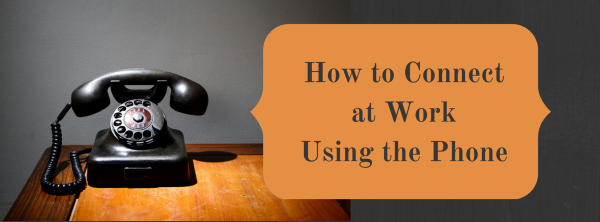![]()
My leadership blog is all about helping current and emerging leaders learn how to transform difficult conversations and dysfunctional workplace relationships into positive and productive ones.


Phone Conversations — How to Connect at Work
Back in the 1920s and ’30s, my grandmother worked for Bell Canada. One of her jobs was to go out to businesses and teach people how to use the newest equipment, such as this piece of cutting-edge technology:
/
/
That’s right. The “dial” phone. While you couldn’t get any apps for it, people still thought this high-tech gadget was pretty cool … and, evidently, complicated.
/
Since that time, advances in telephone technology have gone far beyond anything my grandmother could have even dreamed of.
/
However, one fundamental thing has remained the same: the telephone allows people to talk to each other. (Yes, I said talk, not text.)
/
The quality of workplace relationships (non-work ones, too) is driven by feelings, i.e. the content of the information flowing between the people is actually not that important.
/
There’s a hierarchy of how feelings are most reliably communicated between people:
/
1. Visually
— body language, eye contact
2. Vocally
— tone, pitch, volume, rate
3. Linguistically
— words and how they’re combined
/
So, for those times when a face-to-face conversation or video-chat aren’t possible, pick up the phone! … and then do what? I’m glad you asked!
/
Below is a great infographic I came across, put out by The Gap Partnership. As you read along, you’ll see, beside it, where I’ve shared some of my own extended thoughts with you. The only change I’d make to the title is replacing the word Influencing with Connecting.

My additional thoughts in terms of creating and maintaining positive and productive workplace relationships:
5 Things to do pre-call:
- Creating and maintaining a positive and productive workplace relationship should be part of your purpose in every call. Remind yourself of the feelings you’d like the other person to experience during the call: e.g. supported, encouraged, valued.
- While preparation is important, it’s more important to be fully present in the conversation that emerges.
The secret of a relaxed voice:
- It’s this element that first reminded me of my grandmother. When she was an operator with Bell Canada, all the operators had little mirrors in front of them so they would remember to smile. My grandmother actually received an award for being “The Girl with the Smile in her Voice.” Gotta love that!
The secret to convincing your listener:
- Just change the word in this from “convincing” to “connecting”. The former can put you in a manipulative mindset instead of a relational mindset of mutual respect.
3 tips for using a call script successfully:
- Though this pertains particularly to sales, it’s a good idea to prepare for difficult conversations by mapping out — in point form — what it is you need to say; practice it out loud; then throw away the script and let it come out authentically and naturally in the conversation.
3 tips to listening over the phone:
- Remember, the other person isn’t receiving any visual cues that you are listening and engaged.
What your voice says about you:
- Though it’s good to build your awareness and proficiency in this, don’t hyper-focus on it; if you force this, you run the risk of coming off as insincere.
Dress the part:
- As someone who works at a home office, I’ve got to think this one through a bit! Does one truly need to wear pants whilst one is Skyping?
Establish a rapport:
- Establishing a rapport is a constant. The question is this: are you establishing a good one or a poor one?
- The quality of the relationship shifts with every moment of a conversation.
This post was a long one — thanks for staying on the line!
/
Have a productive and enjoyable day.
/
— Brie
Blog Post

Phone Conversations — How to Connect at Work
Back in the 1920s and ’30s, my grandmother worked for Bell Canada. One of her jobs was to go out to businesses and teach people how to use the newest equipment, such as this piece of cutting-edge technology:
/
 That’s right. The “dial” phone. While you couldn’t get any apps for it, people still thought this high-tech gadget was pretty cool … and, evidently, complicated.
That’s right. The “dial” phone. While you couldn’t get any apps for it, people still thought this high-tech gadget was pretty cool … and, evidently, complicated.
/
Since that time, advances in telephone technology have gone far beyond anything my grandmother could have even dreamed of.
/
However, one fundamental thing has remained the same: the telephone allows people to talk to each other. (Yes, I said talk, not text.)
/
The quality of workplace relationships (non-work ones, too) is driven by feelings, i.e. the content of the information flowing between the people is actually not that important.
/
There’s a hierarchy of how feelings are most reliably communicated between people:
/
1. Visually
— body language, eye contact
2. Vocally
— tone, pitch, volume, rate
3. Linguistically
— words and how they’re combined
/
So, for those times when a face-to-face conversation or video-chat aren’t possible, pick up the phone! … and then do what? I’m glad you asked!
/
Below is a great infographic I came across, put out by The Gap Partnership. As you read along, you’ll see, beside it, where I’ve shared some of my own extended thoughts with you. The only change I’d make to the title is replacing the word Influencing with Connecting.
/
Following the infographic, I’ve added some additional thoughts on it.

My additional thoughts in terms of creating and maintaining positive and productive workplace relationships:
5 Things to do pre-call:
- Creating and maintaining a positive and productive workplace relationship should be part of your purpose in every call. Remind yourself of the feelings you’d like the other person to experience during the call: e.g. supported, encouraged, valued.
- While preparation is important, it’s more important to be fully present in the conversation that emerges.
The secret of a relaxed voice:
- It’s this element that first reminded me of my grandmother. When she was an operator with Bell Canada, all the operators had little mirrors in front of them so they would remember to smile. My grandmother actually received an award for being “The Girl with the Smile in her Voice.” Gotta love that!
The secret to convincing your listener:
- Just change the word in this from “convincing” to “connecting”. The former can put you in a manipulative mindset instead of a relational mindset of mutual respect.
3 tips for using a call script successfully:
- Though this pertains particularly to sales, it’s a good idea to prepare for difficult conversations by mapping out — in point form — what it is you need to say; practice it out loud; then throw away the script and let it come out authentically and naturally in the conversation.
3 tips to listening over the phone:
- Remember, the other person isn’t receiving any visual cues that you are listening and engaged.
What your voice says about you:
- Though it’s good to build your awareness and proficiency in this, don’t hyper-focus on it; if you force this, you run the risk of coming off as insincere.
Dress the part:
- As someone who works at a home office, I’ve got to think this one through a bit! Does one truly need to wear pants whilst one is Skyping?
Establish a rapport:
- Establishing a rapport is a constant. The question is this: are you establishing a good one or a poor one?
- The quality of the relationship shifts with every moment of a conversation.
This post was a long one — thanks for staying on the line!
/
Have a productive and enjoyable day.
/



